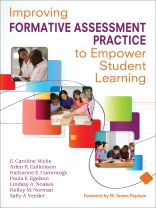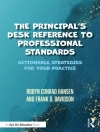Supercharge your formative assessment skills and watch student learning soar!
Teachers routinely ask and answer a series of three questions with and for students: Where are my students headed? Where are they right now? How can I close the gap between where they are and where I want them to be? This text suggests that teachers also ask these parallel questions of themselves:
- Where am I going?
- What can formative assessment practice look like?
- Where am I currently in my formative assessment practice?
- How do I close the gap?
Readers are then encouraged to select a specific aspect of formative assessment to investigate, explore relevant personal practice relevant to that aspect, implement necessary changes, reflect on those changes, and continue the change process.
This practical guide can be used by individual teachers or collaboratively as a study guide for a learning community. The authors describe an effective four-step process for improving teachers′ formative assessment practices that provides opportunities to reflect, consider alternative instructional approaches, and apply what they have learned. Case studies provide examples of formative assessment in practice, along with examples of teacher-implemented changes. A companion website includes an array of tools and templates for organizing, gathering, and systematically using information to strengthen formative assessment skills.This practical guide can be used by individual teachers or collaboratively as a study guide for a learning community. Case studies provide examples of formative assessment in practice, along with examples of teachers implementing changes in their practice. A companion website includes an array of tools and templates for organizing, gathering, and systematically using information to strengthen formative assessment skills.
Spis treści
List of Web Tools
Foreword
Acknowledgments
About the Authors
Preface
Who Is This Book For?
Special Features of This Book
Chapter Highlights
1. Introduction to Improving Formative Assessment Practice
Formative and Summative Assessment
Evaluation and Formative Assessment
Evaluation and Professional Development
The Self-Evaluation Process
Overview of the Chapters
2. Examining Formative Assessment
Formative Assessment in Practice
Understanding Formative Assessment
The Impact of Formative Assessment on Learning
Formative Assessment Characteristics Used in the “How-To Guide”
Summary: The Big Idea of Chapter 2
Questions for Individual Consideration
Questions for Consideration as a Learning Community
3. Getting Started on Your Self-Evaluation Journey
Beginning the Self-Evaluation Process
Developing Familiarity with Formative Assessment
Am I Ready to Engage in This Process?
Summary: The Big Idea of Chapter 3
4. A Targeted Look at One Area
Personal Reflection on Strengths and Areas for Improvement
Collecting Evidence of Practice
Assessing Quality of Information
Selecting an Area for Improvement
Act-Reflect-Revise
Summary: The Big Idea for Chapter 4
5. Support for Making Changes to Practice
The Cycle-Within-The-Cycle: Act, Reflect, Revise
Sources of Support
How Will I Know When I am Ready to Choose a New Target or Characteristic?
Summary: The Big Idea of Chapter 5
6. Self-Evaluation of Changes to Practice
Chain of Evidence
Collecting Evidence of Effects
Sources of Evidence
Additional Considerations
Summing Up
Summary: The Big Idea of Chapter 6
7. Putting It All Together
Index
O autorze
Ms. Norman is an instructional coach working with math and science teachers for Topeka, Kansas, Public Schools. She has a Bachelor of Elementary Education and English Literature from Washburn University. Her teaching experience includes 4th grade and 6th grade math. Ms. Norman serves on her district′s committee for curriculum and assessment and is particularly passionate about the creation, administration, and analysis of formative assessments for the purpose of increasing student achievement in her district. Kelley has been actively involved in the formative assessment work we engaged in through the NSF grant.












